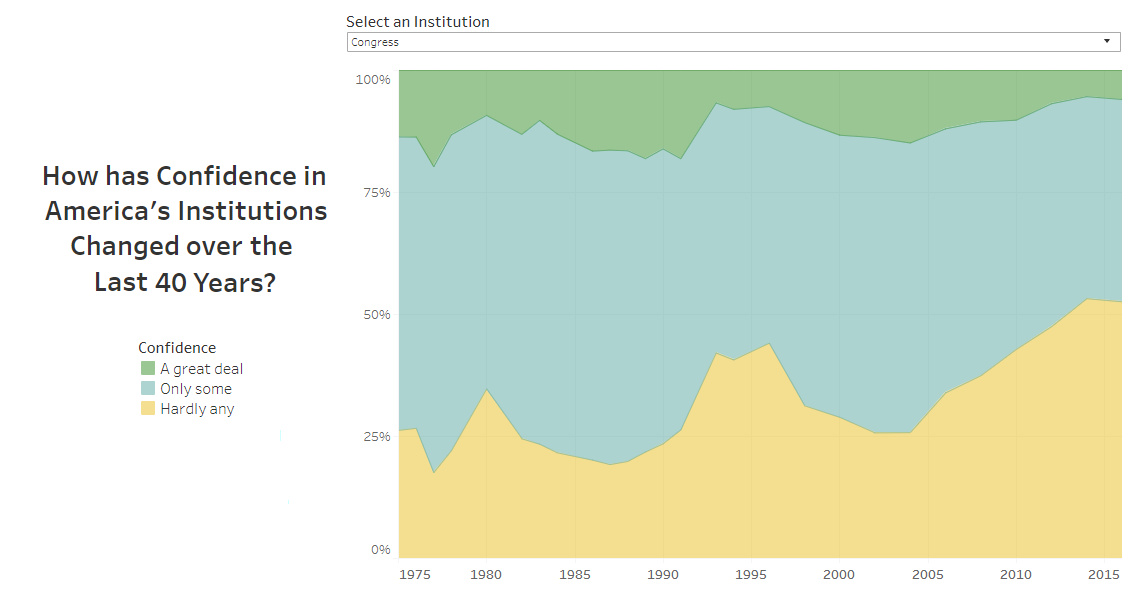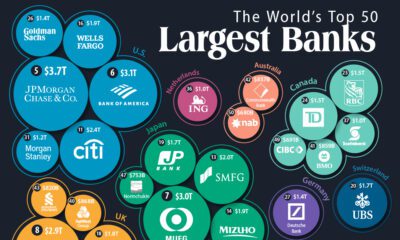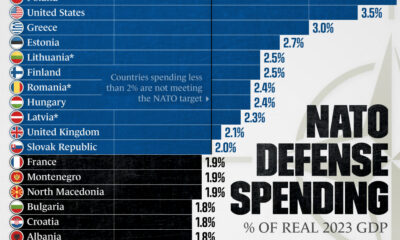Politics
Visualizing the Decline of Confidence in American Institutions
Every day, the public relies on a number of major institutions for services and safety. From banks and governments, to media and the military—these institutions play an important role in shaping life as we know it.
Yet, today’s interactive data visualization from Overflow Data shows that America’s confidence in institutions has drastically waned. The data relies on the General Social Survey (GSS) to provide a 40-year overview of how sentiment has changed with respect to 13 different institutions.
Select an institution from the drop-down menu below to see how confidence has changed over time
The Erosion of Confidence
Overall, confidence in most institutions has eroded. Americans find it especially hard to trust their government: the “great deal of confidence” metrics for Congress, the Supreme Court, and the Executive Branch were low to begin with, and have declined further since 1975.
That said, the biggest overall drop belongs to the press, which saw 50% of surveyed Americans saying they have “hardly any confidence” in it in 2016. This is nearly a three-fold increase from 1975, when that number was just 19%. Of course, with the rise of fake news in more recent years, the erosion of confidence in media doesn’t seem to be slowing down.
Here’s a look at the two extremes of sentiment regarding the studied institutions, showing how the opposite measures of “hardly any confidence” and a “great deal of confidence” have changed since 1975:
| Institution | Confidence level | 1975 | 2016 | Change |
|---|---|---|---|---|
| 🏦 Banks & Financial Institutions | Hardly any | 10.9% | 31.2% | +20.3 p.p. |
| Great deal | 32.3% | 14.1% | -18.2 p.p. | |
| 🗳️ Congress | Hardly any | 26.2% | 52.6% | +26.4 p.p. |
| Great deal | 13.6% | 5.9% | -7.7 p.p. | |
| 🏫 Education | Hardly any | 13.0% | 17.5% | +4.5 p.p. |
| Great deal | 31.5% | 25.6% | -5.9 p.p. | |
| 🏛️ Executive Branch | Hardly any | 29.7% | 42.4% | +12.7 p.p. |
| Great deal | 13.4% | 12.8% | -0.6 p.p. | |
| 🏬 Major Companies | Hardly any | 22.9% | 17.3% | -5.6 p.p. |
| Great deal | 20.5% | 18.3% | -2.2 p.p. | |
| 🏥 Medicine | Hardly any | 17.8% | 13.4% | -4.4 p.p. |
| Great deal | 51.8% | 50.6% | -1.2 p.p. | |
| 🎖️ Military | Hardly any | 14.8% | 7.6% | -7.2 p.p. |
| Great deal | 36.3% | 53.4% | +17.1 p.p. | |
| 💪 Organized Labor | Hardly any | 31.5% | 22.6% | -8.9 p.p. |
| Great deal | 10.2% | 13.9% | +3.7 p.p. | |
| 🙏 Religion | Hardly any | 23.0% | 26.4% | +3.4 p.p. |
| Great deal | 25.8% | 20.0% | -5.8 p.p. | |
| 📰 Press | Hardly any | 19.0% | 50.0% | +31 p.p. |
| Great deal | 24.5% | 7.6% | -16.9 p.p. | |
| 🥼 Scientific Community | Hardly any | 7.4% | 6.1% | -1.3 p.p. |
| Great deal | 41.7% | 42.1% | +0.4 p.p. | |
| 📺 Television | Hardly any | 23.4% | 43.1% | +19.7 p.p. |
| Great deal | 18.4% | 9.8% | -8.6 p.p. | |
| ⚖️ U.S. Supreme Court | Hardly any | 19.2% | 17.4% | -1.8 p.p. |
| Great deal | 31.8% | 26.3% | -5.5 p.p. |
Banks and financial institutions have also suffered a bad rep in the public eye. Their “great deal of confidence” metric has dropped sharply from 32.3% to 14.1% in four decades.
One major exception is the military, which emerges as the most trusted institution. Americans’ faith in the military has also shown the most improvement, with a 17.1 p.p increase in a “great deal of confidence” since 1975.
The Split Widens Further
While measuring public confidence in institutions can be subjective, it provides an understanding of where Americans want to see change and reform take place.
For more on how Americans perceive different institutions and the issues that affect them, see how the public is divided based on political affiliation.
United States
Charted: What Southeast Asia Thinks About China & the U.S.
A significant share of respondents from an ASEAN-focused survey are not happy about rising American and Chinese influence in the region.

What Southeast Asia Thinks About China & the U.S.
This was originally posted on our Voronoi app. Download the app for free on iOS or Android and discover incredible data-driven charts from a variety of trusted sources.
This chart visualizes the results of a 2024 survey conducted by the ASEAN Studies Centre at the ISEAS-Yusof Ishak Institute. Nearly 2,000 respondents were asked if they were worried or welcoming of rising Chinese and American geopolitical influence in their country.
The countries surveyed all belong to the Association of Southeast Asian Nations (ASEAN), a political and economic union of 10 states in Southeast Asia.
Feelings Towards China
On average, a significant share of respondents from all 10 countries are worried about rising influence from both the U.S. and China.
However, overall skepticism is higher for China, at 74% (versus 59% for U.S.).
| Country | Worried About Growing 🇨🇳 Influence | Welcome Growing 🇨🇳 Influence |
|---|---|---|
| 🇧🇳 Brunei | 58% | 42% |
| 🇰🇭 Cambodia | 66% | 34% |
| 🇮🇩 Indonesia | 57% | 43% |
| 🇱🇦 Laos | 68% | 32% |
| 🇲🇾 Malaysia | 56% | 44% |
| 🇲🇲 Myanmar | 95% | 5% |
| 🇵🇭 Philippines | 81% | 19% |
| 🇸🇬 Singapore | 74% | 26% |
| 🇹🇭 Thailand | 84% | 16% |
| 🇻🇳 Vietnam | 96% | 4% |
| Average | 74% | 27% |
The recently-cooled but still active territorial concerns over the South China Sea may play a significant role in these responses, especially in countries which are also claimants over the sea.
For example, in Vietnam over 95% of respondents said they were worried about China’s growing influence.
Feelings Towards America
Conversely, rising American influence is welcomed in two countries with competing claims in the South China Sea, the Philippines (69%) and Vietnam (55%).
| Country | Worried About Growing 🇺🇸 Influence | Welcome Growing 🇺🇸 Influence |
|---|---|---|
| 🇧🇳 Brunei | 73% | 27% |
| 🇰🇭 Cambodia | 58% | 42% |
| 🇮🇩 Indonesia | 73% | 27% |
| 🇱🇦 Laos | 79% | 21% |
| 🇲🇾 Malaysia | 68% | 32% |
| 🇲🇲 Myanmar | 45% | 55% |
| 🇵🇭 Philippines | 32% | 69% |
| 🇸🇬 Singapore | 37% | 63% |
| 🇹🇭 Thailand | 80% | 20% |
| 🇻🇳 Vietnam | 45% | 55% |
| Average | 59% | 41% |
Despite this, on a regional average, more respondents worry about growing American influence (59%) than they welcome it (41%).
Interestingly, it seems almost every ASEAN nation has a clear preference for one superpower over the other.
The only exception is Thailand, where those surveyed were not a fan of either option, with 84% worried about China, and 80% worried about the U.S.
-

 Business6 days ago
Business6 days agoThe Top Private Equity Firms by Country
-

 Countries2 weeks ago
Countries2 weeks agoCountries With the Largest Happiness Gains Since 2010
-

 VC+2 weeks ago
VC+2 weeks agoVC+: Get Our Key Takeaways From the IMF’s World Economic Outlook
-

 Demographics2 weeks ago
Demographics2 weeks agoThe Countries That Have Become Sadder Since 2010
-

 Money2 weeks ago
Money2 weeks agoCharted: Who Has Savings in This Economy?
-

 Technology2 weeks ago
Technology2 weeks agoVisualizing AI Patents by Country
-

 Economy2 weeks ago
Economy2 weeks agoEconomic Growth Forecasts for G7 and BRICS Countries in 2024
-

 Wealth1 week ago
Wealth1 week agoCharted: Which City Has the Most Billionaires in 2024?















